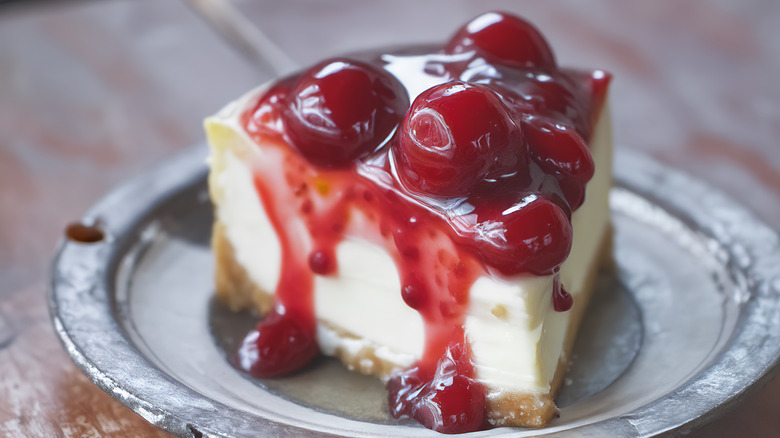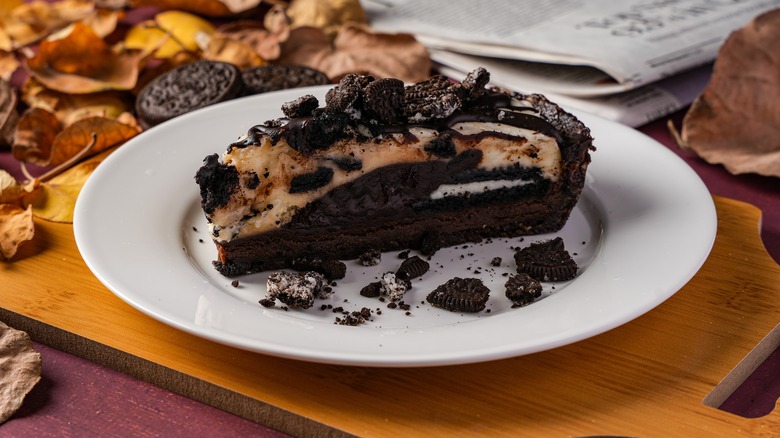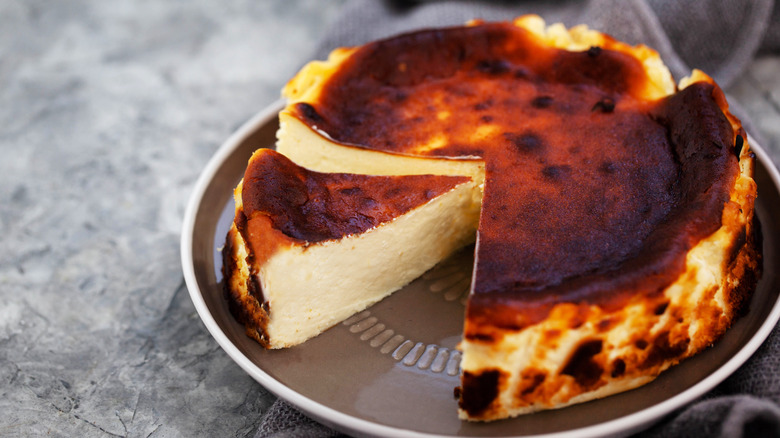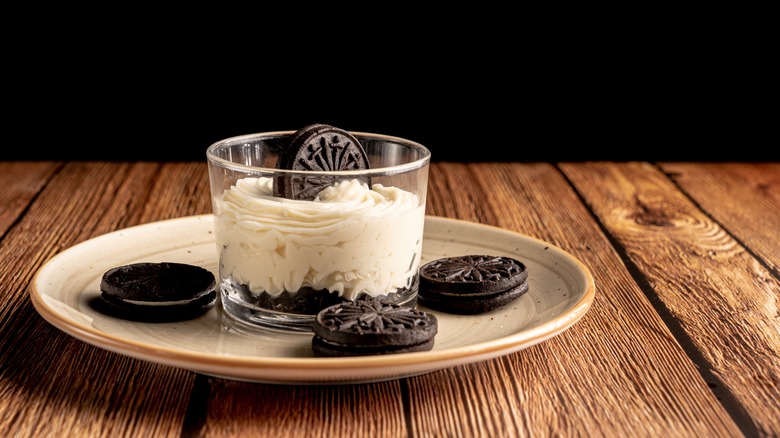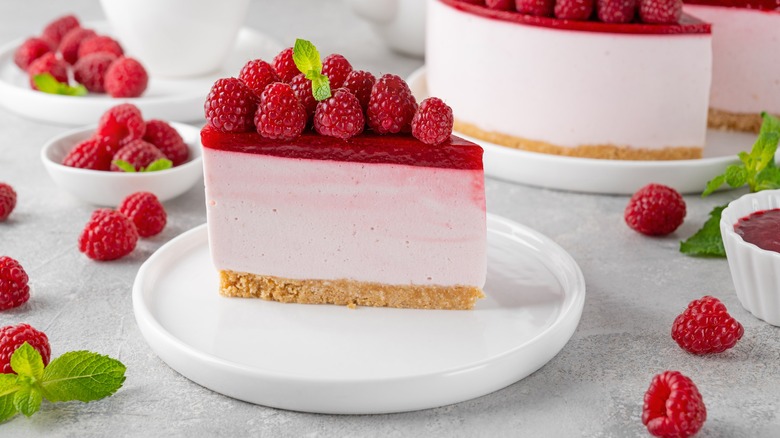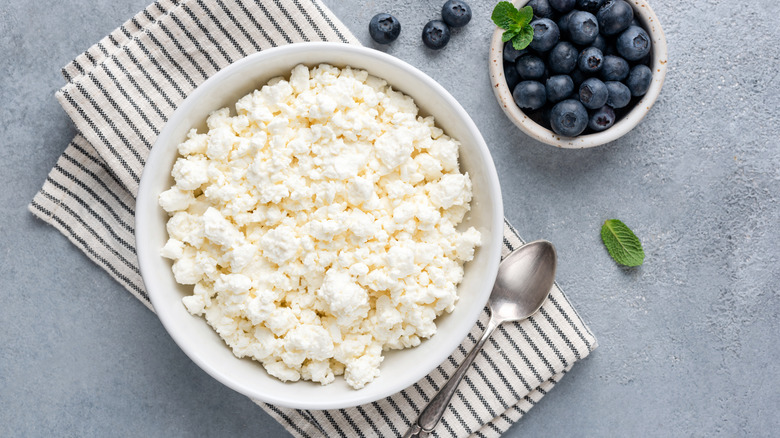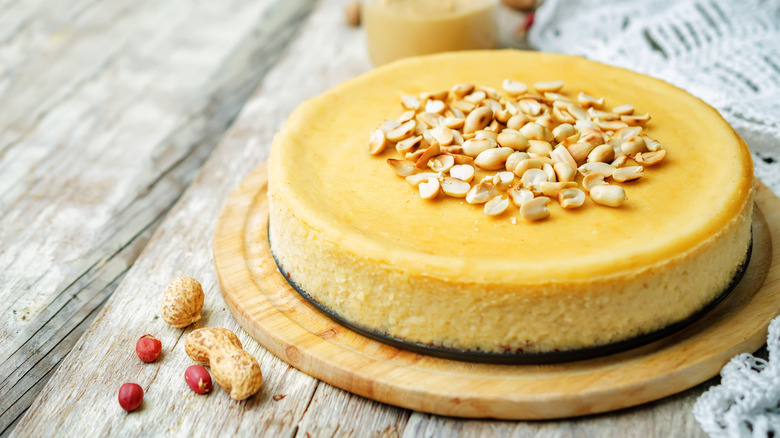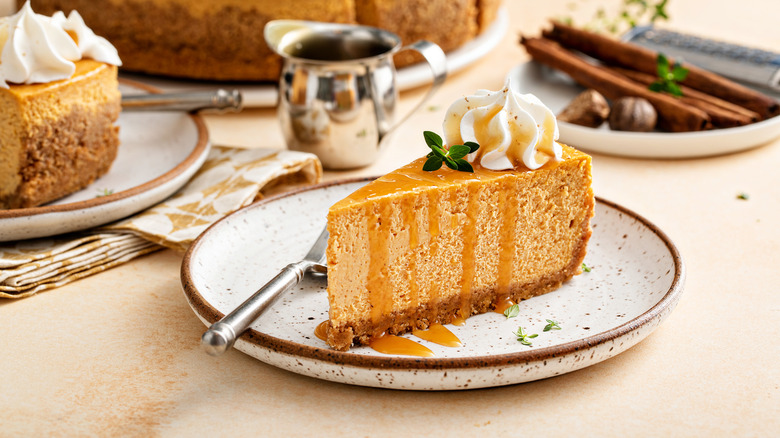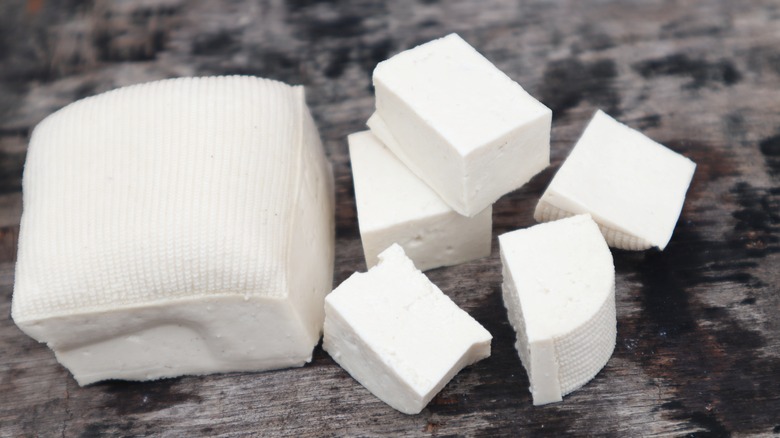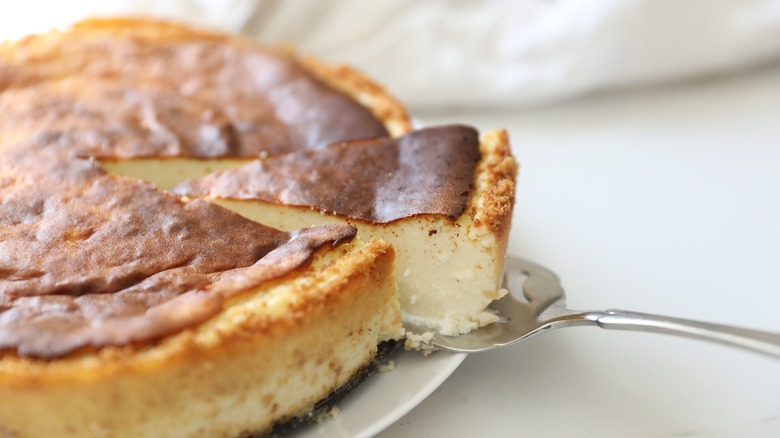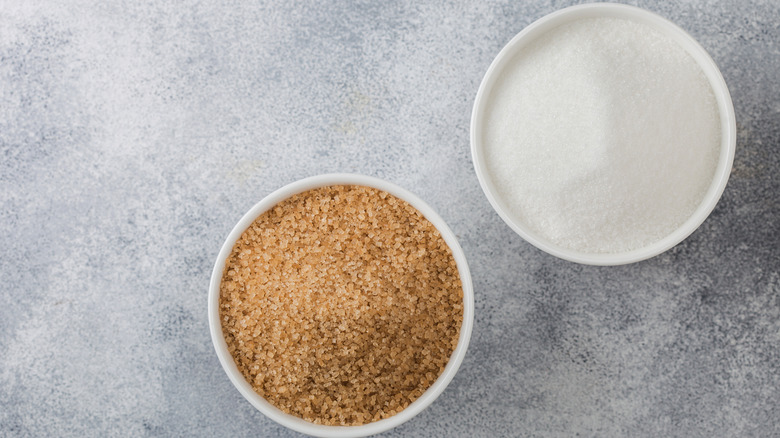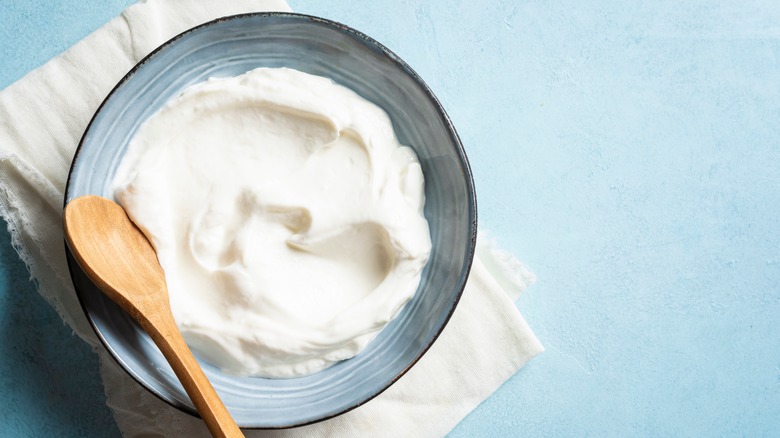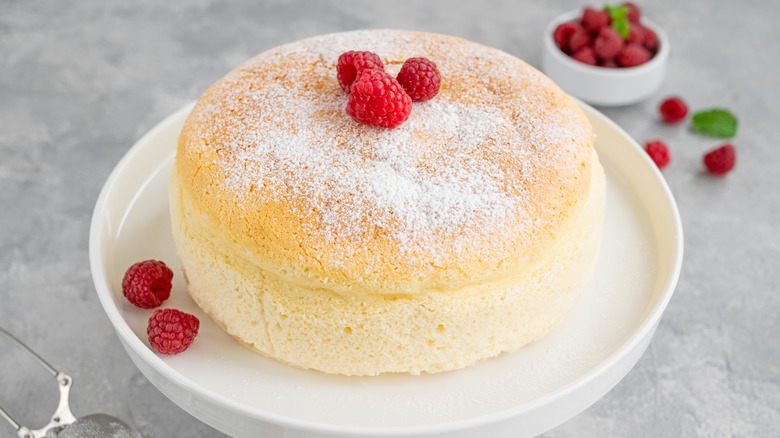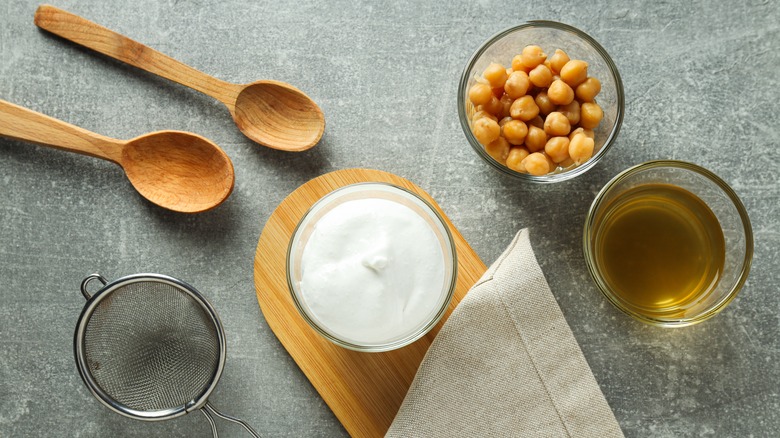13 Ingredient Swaps That Will Make Your Cheesecake So Much Better
Few desserts are as enticing, comforting, or nostalgic as a fluffy, tangy, creamy classic baked cheesecake. Indeed, humans have been consuming a version of this recipe for roughly 2,000 years, since it first made an appearance in Ancient Greece. Since then, it's undergone various permutations, including the incorporation of eggs and the addition of a graham cracker crust. While there are a number of tips and tricks for baking the best cheesecake, you can also jazz one up using some basic ingredient swaps.
That's where my expertise comes into play. As a professional chef with nearly two decades of experience, I've baked many cheesecakes in my career. While some remained faithful to the basic formula, others incorporated unique ingredients or utilized different preparation methods to create something innovative and even more delectable. From different crusts to ways to augment the cream cheese, no variation is off limits in my kitchen, and I'm sharing my winning swaps with you here, so that you can turn your cheesecake recipe into something extraordinary.
1. Swap out the graham crackers with a different crust
While graham crackers are the quintessential crust for a cheesecake, plenty of other options exist that can perform the same function and be equally delicious and more interesting. The crust performs a number of different functions. It acts as a container for the filling, preventing it from escaping the confines of the springform baking pan. It also helps to provide textural complexity between the creamy cheese filling and the crunchy base. Lastly, it can infuse the entire thing with added flavor, helping to balance out the tanginess of the cheesy filling.
Any substitution for the slightly sweet and nutty graham crackers will have to have to fill big shoes to compete for this job. Some of the best alternatives to a graham cracker crust include crumbled gingersnaps, ground nuts, crushed pretzels, and pulverized cereal. I prefer these either because they have an intense spicy quality or a sweet and savory element, which is ideal for complementing the bite of the cheese filling. That said, if you're a fan of sweeter options, like Oreos, chocolate chip or peanut butter cookies, or even brownies, have at it. These can all make for a great cheesecake base.
2. Skip the crust altogether
Baking a crustless cheesecake is not uncommon. Just look at a burnt Basque cheesecake for all the inspiration you need. In fact, this is how they were produced in the early days, when the Greeks simply pounded cheese together with honey and flour, until it was shaped into an orb and baked. It wasn't until eggs were added, and the filling became thinner, that a crust became more advantageous.
When choosing to bake a crustless cheesecake, there are a few things to consider. First, you'll need to make sure you have a springform pan that seals very tightly, so that the filling doesn't all leak out. Alternatively, make sure you wrap the edges of the pan with aluminum foil to seal it well. You will also want to line the pan with parchment paper to ensure the cake doesn't adhere to it.
As far as the cheesecake base goes, it will need to be somewhat denser than what you might otherwise use, which will help it hold its shape. Lastly, run a knife around the edges of the pan to help loosen the cake before you try to remove it. This is always important, but doubly so when baking a cheesecake without a crust.
3. Use mascarpone instead of cream cheese
If you've ever eaten an authentic tiramisu, you'll already be familiar with the luxurious quality of mascarpone cheese. While similar to cream cheese, this Italian dairy product is less tangy and a bit more refined. It has an ultra-velvety texture and richness because it's produced using heavy cream, which means it contains 60% to 75% milk fat. Cream cheese, by contrast, is made from whole milk and contains 33% milk fat, on average. Because they're quite similar, mascarpone can easily be swapped for cream cheese in a cheesecake, but doing so requires a little bit of finesse to accommodate for its higher milk fat and somewhat sweeter flavor profile.
While it may be tempting to simply replace the cream cheese one-to-one with mascarpone without altering any other ingredients, doing so may result in an assertively sweet cheesecake. I'd recommend that you reduce the sugar content by about a quarter to a third to accommodate for this. Additionally, because of its high fat content, mascarpone can easily be over-mixed, which can result in a lumpy cheesecake. By ensuring the mascarpone is at room temperature, you'll be able to quickly and evenly combine the ingredients without overbeating the cheese.
4. Try a no-bake variation with instant pudding
If you're craving cheesecake on a hot summer day and don't want to overheat your kitchen by turning on your oven to bake one, a no-bake variation is a great way to satisfy that sweet tooth. Though it takes a little time to set up in the refrigerator, it is relatively easy to pull together and can produce a delectable iteration of this classic dessert. That said, some no-bake cheesecake recipes leave something to be desired in the texture department. They can turn out on the weepy or soupy side, lacking the structural integrity that you gain from heating eggs in the oven. As the protein strands found in egg yolks begin to warm up, they denature, meaning they stretch out, absorbing water and attaching to one another. This is what causes the cheesecake to thicken. Without the assistance of some kind of binder, no-bake cheesecake recipes can lack this richness.
One ingredient that you can swap for eggs to help a no-bake cheesecake develop a velvety texture is instant pudding. This is made from modified cornstarch, which will act as the glue to bind your cheesecake ingredients together. And, as a bonus, you can obtain instant pudding in numerous flavors, including vanilla, chocolate, strawberry, or lemon, each of which will produce a uniquely-flavored no-bake cheesecake.
5. Boost the protein with cottage cheese
If you're looking to retain the tangy, velvety quality of cream cheese while increasing the protein content of your cheesecake, take a hint from celebrity chef Alton Brown and swap it with cottage cheese. Cottage cheese is one of my favorite dairy products for cooking and baking. While it may not seem ideal for a creamy dessert, due to its lumpy consistency, it can easily be transformed into a luscious texture with the help of a food processor or blender. The key is using the right kind.
With so many brands, curd sizes, and fat contents available, it can be a dizzying feat to figure out which cottage cheese to use for a cheesecake recipe. My rule of thumb is to always opt for a full-fat cottage cheese and to choose a small-curd variety. I find this to have the best texture when you purée it in a food processor, though it still may be more loose than cream cheese. If you're concerned about excess moisture ruining your cheesecake, you can always strain the cottage cheese before whizzing it in a food processor to eliminate any excess whey that could water down the filling. Measure the cottage cheese using a scale to ensure you're using the same amount by weight as you would of cream cheese.
6. Add peanut butter with the cream cheese
Peanut butter is always a great addition to a dessert recipe. Its inherent salty qualities help to balance out sweetness, and its fat content helps to add a level of creaminess that can make even the perfect cheesecake even dreamier. As a bonus, peanut butter is a great source of protein, giving your cheesecake an extra nutritional boost. While it may be tempting to simply swap some of the cream cheese with peanut butter and run with it, there are a few considerations to make before adding this nutty delight to your next cheesecake recipe.
Natural peanut butter is not necessarily ideal for baking because, without emulsifiers, the fat has a tendency to separate from the peanut solids. For ease of preparation, I typically recommend a standard, creamy (not chunky) peanut butter for use in a cheesecake recipe. The peanut butter should be at room temperature before being added to the filling so that it can easily be incorporated without remaining clumpy. Lastly, if you plan to substitute equal parts of cream cheese with peanut butter, you may need to reduce the amount of sour cream and butter used to keep the filling from becoming too loose to set properly in the oven.
7. Mix in canned pumpkin purée instead of sour cream
If you are looking to swap your usual pumpkin pie with an alternative dessert this Thanksgiving, leftover canned pumpkin purée is the secret ingredient that can completely transform a classic cheesecake recipe into a festive holiday delight. Because of its moisture content, you'll want to substitute the sour cream with equal parts pumpkin purée, keeping in mind that you may sacrifice some of the tanginess conferred by the former. Also, be careful not to use pumpkin pie filling, as this is pre-sweetened and seasoned, which will throw off the sugar content of your cheesecake recipe.
While many basic cheesecake recipes only call for the addition of vanilla extract to help season the filling, this is the time to get fancy with spices to help confer some of the characteristic warmth of a classic pumpkin pie. While you could go the pumpkin or apple pie spice route, why not get a little exotic with your seasonings and opt for a Chinese five-spice blend? This spice combination, which contains star anise, cloves, cinnamon, Sichuan peppercorns, and fennel seeds, performs well when added to savory and sweet recipes alike. In a pumpkin cheesecake, it can completely transform the recipe from something vegetable-y, to something complex and sophisticated.
8. Make it vegan with silken tofu instead of cream cheese
Silken tofu is a secret ingredient in many recipes requiring a dairy-free or vegan option for creating a creamy texture. Cheesecake is no different. While you may think you don't need to be dairy-free or vegan and that silken tofu cheesecake sounds unappealing, you'd be shocked at how luxurious it can be, and how well it can mimic the qualities that cream cheese confers to a cheesecake. While there are recipes for both baked and no-bake varieties of cheesecake using silken tofu, I prefer the no-bake ones as the high moisture content of this soy product can make it a little fickle to work with.
For the uninitiated, silken tofu is made without curdling the soy milk, and it is not pressed, yielding a moist, pudding-like texture. Before using silken tofu for cheesecake you may need to drain off the excess moisture by leaving it to dry on a layer of paper towels before adding it to the recipe. Rather than adapting an existing cheesecake recipe here, I recommend using one that has been developed using silken tofu. This will guarantee that the final cheesecake sets properly and doesn't fall apart when you remove it from the baking pan.
9. Swap the cream cheese with ricotta for Italian flair
One of my favorite cheesecake recipes includes an Italian delicacy, known as ricotta, which produces a not-overly-sweet dessert that makes a pleasant ending to an otherwise rich meal. Ricotta literally translates to "recooked." It's a cheese made by reheating the whey leftover from the cheesemaking process. The leftover curds are strained and concentrated. While it may have some similarities to cottage cheese, its curds are notably smaller and it lacks that intense tanginess.
When substituting cream cheese with ricotta, it's helpful to use the full-fat variety, and to purée it together using a food processor or blender, to break up any remaining chunks. Unlike cottage cheese, you won't need to drain ricotta as there is typically very little residual moisture in the container. You can swap ricotta one-for-one with cream cheese, measuring by weight rather than volume. Combine the remaining ingredients as instructed in the recipe and bake as recommended. To add some Italian flair to the filling, I typically toss in some almond extract and a hint of lemon or orange zest, which may remind you of a classic torta caprese, a delicacy found on the Isle of Capri.
10. Use brown sugar instead of granulated sugar for rich caramel notes
When it comes to baking, sugar performs a number of duties, from sweetening the dessert, to helping it to leaven, to keeping it moist and even preserving it. In a cheesecake, granulated sugar is often used to keep the color of the filling a pristine white hue. While this may be aesthetically pleasing, there are a few reasons you might want to swap granulated sugar with light or dark brown sugar in your next cheesecake recipe. Brown sugar is made by incorporating molasses into regular, refined sugar, giving it a rich, caramel-forward flavor and helping to infuse it with a higher moisture content, which is the reason why it can turn into a dense brick when it is improperly stored.
Although you can't always substitute white for brown sugar in a one-to-one ratio, in a cheesecake, it's pretty safe to do so, as the sugar is not necessarily actively involved in helping the cheesecake to rise. Be sure to combine the brown sugar thoroughly with the eggs before adding these to your cream cheese to ensure there's no residual graininess that may be detectable in the finished dessert. You'll notice there will be a tan hue to your finished cake. Accentuate this by adding sweet spices to the mix, like cinnamon, cloves, allspice, and nutmeg.
11. Sneak in Greek yogurt for the tang of sour cream
While Greek yogurt is a common swap for sour cream in recipes for dips, there are many ways these two dairy products can be used one-to-one in recipes where a creamy but tangy component is required. Cheesecake is one of those. Sour cream helps to balance out the density of cream cheese while conferring a similar flavor profile. Greek yogurt has this sourness, while also containing a few extra qualities, like probiotics, that make it a nutritious and delicious ingredient for baking a cheesecake. It also typically contains less fat without sacrificing any flavor or texture.
When opting to use Greek yogurt over sour cream in a cheesecake recipe, make sure you choose one that's full-fat. This will give it the right texture when added to your favorite cheesecake recipe. You'll also want to avoid purchasing flavored Greek yogurt or anything with fruit on the bottom. These are often loaded with sugar, and the fruit will interfere with the texture and sweetness of the final dessert. Lastly, don't be tempted to use plain yogurt. Its texture is thinner than the Greek variety, which may result in a cheesecake that won't set properly when baked.
12. Go with a Japanese-inspired approach using meringue instead of whole eggs
Among the many Japanese desserts you should enjoy at least once in your life is a delightfully fluffy cheesecake, known as cotton cake, made using egg whites beaten into a meringue. The resulting texture of this cheesecake is like a marriage between a classic cheesecake and a soufflé, making it impossibly light and airy. Most cheesecake recipes combine whole eggs with the remaining ingredients, delivering a base that's rich and creamy, if not slightly dense. Though some are more or less fluffy depending on the exact proportion of cream cheese to eggs and sugar, the overall technique that can be incorporated into any cheesecake recipe.
Begin by separating the egg yolks from the whites and dividing the sugar in half. Set aside the egg whites and half the sugar and combine the remaining ingredients in a bowl using a stand mixer. Next, beat the egg whites into stiff peaks, slowly adding the sugar until the mixture turns a glossy white. Carefully fold this meringue into the egg yolk base, being careful not to deflate the meringue. Bake the cake as instructed, in a hot water bath, until just set, giving a fluffy, golden brown finish.
13. Try the magical qualities of aquafaba instead of eggs
Speaking of airy cheesecakes made with meringue, if you are seeking a vegan alternative to eggs that can lift your recipe to new heights, both literally and figuratively, you might want to start saving the liquid from those canned chickpeas you have been using to make homemade hummus. This liquid gold is known as aquafaba, and it's a magical ingredient with many practical uses, including replacing the eggs in all your baked goods. Aquafaba roughly translates to "bean water," and the unique starchiness of this liquid helps to bind your cakes and other baked goods similarly to eggs.
As a general rule, one egg can be swapped with three tablespoons of aquafaba. If you're concerned about the flavor transferring to your final baked item, don't worry. The amount needed is unlikely to alter the taste noticeably. Though you can use the aquafaba as is, try beating it into a meringue and using it to create a light, airy cheesecake similar to the Japanese cotton cake for something truly special. If you're having trouble getting your aquafaba to form stiff peaks, try adding a couple of pinches of cream of tartar to them to firm them up.
